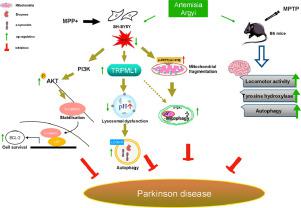Phytomedicine ( IF 6.7 ) Pub Date : 2022-06-15 , DOI: 10.1016/j.phymed.2022.154250 Li-Kung Wu , Surbhi Agarwal , Chia-Hua Kuo , Yen-Lun Kung , Cecilia Hsuan Day , Pi-Yu Lin , Shinn-Zong Lin , Dennis Jine-Yuan Hsieh , Chih-Yang Huang , Chien-Yi Chiang

|
Background
Parkinson's disease (PD) is a neurodegenerative disorder involving the degeneration of dopaminergic neurons in the substantia nigra pars compacta (SNpc). Cellular clearance mechanisms, including the autophagy-lysosome pathway, are commonly affected in the pathogenesis of PD. The lysosomal Ca2+ channel mucolipin TRP channel 1 (TRPML1) is one of the most important proteins involved in the regulation of autophagy. Artemisia argyi Lev. et Vant., is a traditional Chinese herb, that has diverse therapeutic properties and is used to treat patients with skin diseases and oral ulcers. However, the neuroprotective effects of A. argyi are not explored yet.
Hypothesis
This study aims is to investigate the neuroprotective effects of A. argyi in promoting the TRPML1-mediated autophagy/mitophagy-enhancing effect
Methods
In this study, we used 1-methyl-4-phenyl-pyridinium (MPP+)-induced PD model established in an SH-SY5Y human neuroblastoma cell line as well as in a 1-methyl-4-phenyl-1,2,3,6-tetrahydro-pyridine (MPTP)-induced PD model in C57BL/6 J mice. MTT assay was conducted to measure the cell viability and further MitoSoX and DCFDA assay were used to measure the ROS. Western blot analysis was used to access levels of TRPML1, p-DRP1 (ser616), p-AKT, PI3K, and β-catenin, Additionally, IF and IHC analysis to investigate the expression of TRPML1, LC3B, β-catenin, TH+, α-synuclein. Mitotracker stain was used to check mitophagy levels and a lysosomal intracellular activity kit was used to measure the lysosomal dysfunction. Behavioral studies were conducted by rotarod and grip strength experiments to check motor functions.
Results
In our in vitro study, A. argyi rescued the MPP+-induced loss of cell viability and reduced the accumulation of mitochondrial and total reactive oxygen species (ROS). Subsequently, it increased the expression of TRPML1 protein, thereby inducing autophagy, which facilitated the clearance of toxic accumulation of α-synuclein. Furthermore, A. argyi played a neuroprotective role by activating the PI3K/AKT/β-catenin cell survival pathway. MPP+-mediated mitochondrial damage was overcome by upregulation of mitophagy and downregulation of the mitochondrial fission regulator p-DRP1 (ser616) in SH-SY5Y cells. In the in vivo study, A. argyi ameliorated impaired motor function and rescued TH+ neurons in the SNpc region. Similar to the results of the in vitro study, TRPML1, LC3B, and β-catenin expression was enhanced in the SNpc region in the A. argyi-treated mice brain.
Conclusion
Thus, our results first demonstrate that A. argyi can exert neuroprotective effects by stimulating TRPML1 and rescuing neuronal cells by boosting autophagy/mitophagy and upregulating a survival pathway, suggesting that A. argyi can further be exploited to slow the progression of PD.
中文翻译:

在 MPP+/MPTP 诱导的帕金森病的体外和体内模型中,蒿叶提取物通过 TRPML1 激活和促进自噬/线粒体清除来保护神经元毒性
背景
帕金森病 (PD) 是一种神经退行性疾病,涉及黑质致密部 (SNpc) 中多巴胺能神经元的退化。细胞清除机制,包括自噬-溶酶体途径,通常在 PD 的发病机制中受到影响。溶酶体 Ca 2+通道粘蛋白 TRP 通道 1 (TRPML1) 是参与调节自噬的最重要的蛋白质之一。艾蒿列弗。et Vant.是一种传统中草药,具有多种治疗特性,用于治疗皮肤病和口腔溃疡患者。然而,A.argyi的神经保护作用尚未探索。
假设
本研究旨在研究A.argyi在促进 TRPML1 介导的自噬/线粒体自噬增强作用中的神经保护作用
方法
在这项研究中,我们使用了在 SH-SY5Y 人神经母细胞瘤细胞系以及 1-methyl-4-phenyl-1,2,3 中建立的 1-methyl-4-phenyl-pyridinium (MPP+) 诱导的 PD 模型,6-四氢吡啶 (MPTP) 诱导的 C57BL/6 J 小鼠 PD 模型。进行 MTT 测定以测量细胞活力,并进一步使用 MitoSoX 和 DCFDA 测定来测量 ROS。蛋白质印迹分析用于访问 TRPML1、p-DRP1 (ser616)、p-AKT、PI3K 和 β-连环蛋白的水平,此外,IF 和 IHC 分析用于研究 TRPML1、LC3B、β-连环蛋白、TH+ 的表达, α-突触核蛋白。使用 Mitotracker 染色检查线粒体自噬水平,并使用溶酶体细胞内活性试剂盒测量溶酶体功能障碍。通过旋转棒和握力实验进行行为研究,以检查运动功能。
结果
在我们的体外研究中,A.argyi挽救了 MPP+ 诱导的细胞活力丧失,并减少了线粒体和总活性氧 (ROS) 的积累。随后,它增加了 TRPML1 蛋白的表达,从而诱导自噬,这有助于清除 α-突触核蛋白的毒性积累。此外,A.argyi通过激活 PI3K/AKT/β-catenin 细胞存活通路发挥神经保护作用。MPP+ 介导的线粒体损伤被 SH-SY5Y 细胞中线粒体自噬的上调和线粒体裂变调节因子 p-DRP1 (ser616) 的下调所克服。在体内研究中,A.argyi改善了受损的运动功能并拯救了 SNpc 区域的 TH+ 神经元。与体外研究的结果相似,TRPML1、LC3B 和 β-连环蛋白的表达在 A.argyi处理的小鼠大脑的SNpc区域中增强。
结论
因此,我们的研究结果首先表明,艾蒿可以通过刺激 TRPML1 发挥神经保护作用,并通过促进自噬/线粒体自噬和上调生存途径来拯救神经元细胞,这表明可以进一步利用艾蒿来减缓 PD 的进展。











































 京公网安备 11010802027423号
京公网安备 11010802027423号